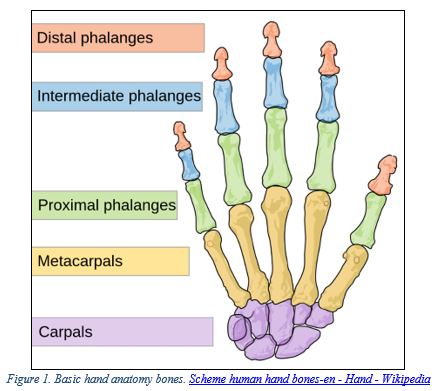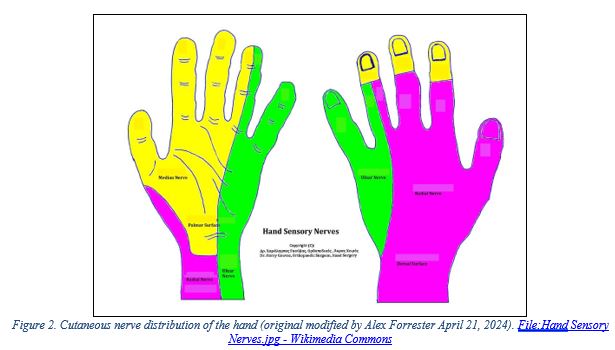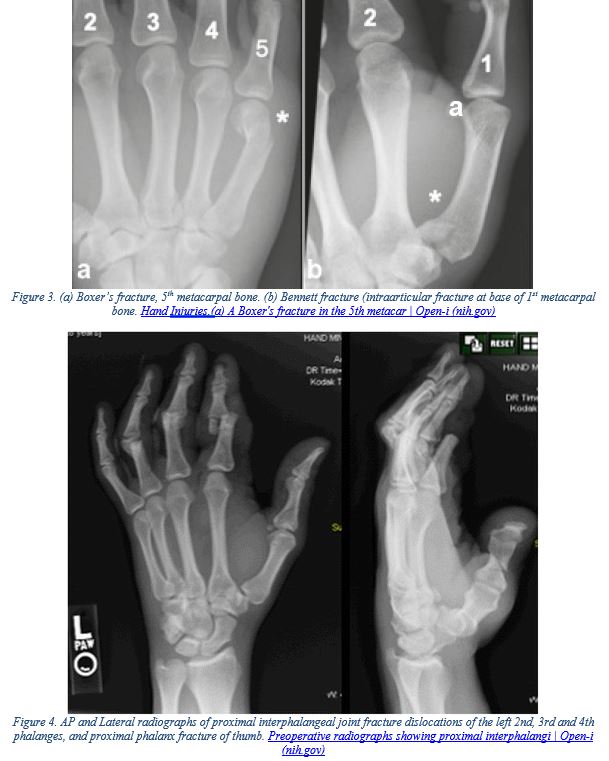Hand & Finger Fractures
Orthopedic, Trauma
First 5 minutes
- Clean and cover open fractures.
- Remove constrictions (i.e., jewelry, watch, gloves etc.) and assess neurovascular status and compartment pressure (compartment syndrome).
- Pain management (digital nerve or metacarpal block).
Context
- Hand fractures are one of the most common injuries resulting from trauma (blunt, penetrating or crush)[1].
- Consider pathological cause like osteoporosis, enchondroma, tumor or infection [1][2].
- Understanding hand anatomy is a crucial part of recognizing and diagnosing hand fractures.


Diagnostic Process
- History [3] [4]
- Mechanism of injury (MOI).
- Handedness.
- Previous finger / wrist injuries.
- Occupation / hobbies / sports.
- Hand Exam (see video link below) [1] [4] [5]
- Visual Inspection
- Open wounds / penetrating objects.
- Deformity (rotational or angular) / atrophy.
- Parallel phalanges when hand in a fist.
- Palpation
- Passive and active range of motion.
- Tendons
- Flexor digitorum profundus (FDP) – immobilize MCP and PIP, flex DIP against resistance.
- Flexor digitorum superficialis (FDS) – immobilize other digits (especially DIP’s), flex PIP against resistance.
- Extensor tendons – hand laying flat, lift fingers individually.
- Elson’s test for central slip (see video below).
- Vascular Assessment
- Capillary refill ≤ 2 seconds.
- Allen Test.
- Neurological Assessment
- Motor – Quick test via “Rock, Paper Scissor”, each movement corresponds with motor nerve function Rock (Median), Paper (Radial), Scissor (Ulnar)[6].
- Sensation – Median, test sensation at distal 2nd Radial, test sensation dorsal webspace of 1st and 2nd digit. Ulnar, test lateral aspect of 5th digit[4].
- Visual Inspection
Video: Trauma Hand Examination (youtube.com)
Video: Elsons test (youtube.com)
- Imaging
- Anteroposterior (AP), Oblique and Lateral X-Rays.
- Imaging of the contralateral hand can be done for comparison (especially in younger patients).
- Ultrasound useful for phalanx fractures, and assessment of soft-tissue injury.
- Diagnosis is based on fracture location, orientation, displacement, angulation, open vs. closed, comminution and joint involvement. Pathological process leading to the fracture should also be noted[2]. Common fractures include[3]:
- Bennett’s fracture (intraarticular fracture at base of 1st MCP).
- Rolandos’ fracture (comminuted base of 1st MCP).
- Boxer’s fracture (fracture of 4th or 5th MC caused by axial load, associated with punching a person or object).
- Phalanx fracture (proximal, distal/tuft or middle).
- Thumb fracture.
- MC Fracture (head, neck, shaft, base).
- High probability of avulsion fractures with hand injuries, exam tendon and ligament attachments[7].

Recommended Treatment
- Early mobilization is recommended, and uninvolved fingers should be free to move. Immobilization of hand fractures > 4 weeks is rarely necessary[2].
- Early pain management can be accomplished through nerve blocks, either digital or metacarpal (see videos). Note, nerve blocks to be done after neurologic assessment[2] [8] [9] [10] [11].

Criteria For Hospital Admission
- Other serious injuries related to trauma.
- Unstable patient.
- Infection.
- Surgery.
Criteria For Transfer To Another Facility
- Surgery required, cannot be performed at current facility.
- Current facility unable to manage patient with other trauma related injuries.
Criteria For Close Observation And/or Consult
General indications for surgical consult include, open fractures, intra-articular fractures, poly-trauma, unreducible fracture; and nerve, vessel, or soft-tissue damage. If in doubt, seek surgical consult[2].

Criteria For Safe Discharge Home
- If patient admitted for surgery, discharge by admitting service.
- If fracture reduced in ED [13][2]:
- Pain adequately managed.
- All associated wounds cleaned and bandaged.
- Antibiotics & Tetanus booster (if required).
- Patient education complete (see patient discharge sheets).
Quality Of Evidence?

High
We are highly confident that the true effect lies close to that of the estimate of the effect. There is a wide range of studies included in the analyses with no major limitations, there is little variation between studies, and the summary estimate has a narrow confidence interval.
Moderate
We consider that the true effect is likely to be close to the estimate of the effect, but there is a possibility that it is substantially different. There are only a few studies and some have limitations but not major flaws, there are some variations between studies, or the confidence interval of the summary estimate is wide.
Low
When the true effect may be substantially different from the estimate of the effect. The studies have major flaws, there is important variations between studies, of the confidence interval of the summary estimate is very wide.
Justification
There is a substantial amount of literature, blog and wiki type forums, and videos that provide diagnostic and treatment options for hand fractures. Not all information is relevant in the ED setting.
Related Information
OTHER RELEVANT INFORMATION
Patient Discharge Sheet
Finger Fracture Care Instructions (Alberta): Finger Fracture: Care Instructions (alberta.ca)
Hand Fracture Care Instructions: Broken Hand Recovery | Hand Fracture Splint, Treatment & Healing Time (healthgrades.com)
Finger, Hand, and Wrist Injuries (HealthLink BC): Finger, Hand, and Wrist Injuries | HealthLink BC
- Hand Anatomy Animated Tutorial – YouTube
- Dalhousie Department of Plastic Surgery – Trauma Hand Examination (youtube.com)
- Closed Reduction of 5th Metacarpal – Closed Reduction of 5th Metacarpal Fracture (youtube.com)
- Emergency Medicine Cases Podcast, Episode 178: Hand Injuries – Pitfalls in Assessment | Emergency Medicine Cases
- Emergency Medicine Cases Podcast, Episode 179: Hand Injuries – Finger Tip Injuries, Jersey Finger, PIP Dislocations, Metacarpal Fractures, Thumb Injuries, Tendon Lacerations | EM Cases (emergencymedicinecases.com)
- Emergency Medicine Cases Podcast, Episode 190: Carpal Bone Injuries – The Big 4 | Emergency Medicine Cases
Reference List
D. J. McDaniel and U. H. Rehman, Phalanx Fractures of the Hand, Treasure Island , Florida: StatPearls Publishing, 2023.
C. M. Meals and R. M. Meals, “Hand Fractures: A Review of Current Treatment Strategies,” The Journal of Hand Surgery, vol. 38, pp. 1021 – 1031, May 2013.
R. Donaldson, J. Swartz, M. Holtz and D. Ostermayer, “Hand and Finger Fractures,” 22 March 2023. [Online]. Available: https://wikem.org/wiki/Hand_and_finger_fractures.
J. Swartz, R. Donaldson, N. Young, P. O. D. Lin, M. Holtz and C. Kim, “Hand Exam,” 25 October 2023. [Online]. Available: https://wikem.org/wiki/Hand_exam.
R. L. Werntz and M. Varacallo, Metacarpal Fracture, Treasure Island, Florida: StatPearls, 2023.
J. Kong, “Rock Paper Scissors: A Mnemonic for Testing Peripheral Nerve Motor Functions of the Hand,” 27 August 2019. [Online]. Available: https://canadiem.org/rock-paper-scissors-testing-peripheral-hand-nerve-motor-function/.
J. Li, Z. Ghulam-Jelani and N. Hoekzema, “Peri-articular fractures of the hand,” Journal of Hand Surgery (European Volume), pp. 35S – 41S, September 2023.
J. Chandrasoma, K. Harrison, H. Ching, L. Vokach-Brodsky and L. Chu, “Peripheral Nerve Blocks for Hand Procedures,” The New England Journal of Medicine, vol. 379, pp. e(15)1 – e(15)5, 6 September 2018.
D. M. Distefano and D. A. Sayal, “EP 178 Hand Injuries – Pitfalls in Assessment and Management,” 1 January 2023. [Online]. Available: https://emergencymedicinecases.com/hand-injuries-assessment-management/. [Accessed 27 February 2024].
P. S. Dalhousie, “Single Injection Volar Digital Block,” 17 February 2015. [Online]. Available: https://www.youtube.com/watch?v=G6jyw7l3bZs. [Accessed 20 April 2024].
P. S. Dalhousie, “Metacarpal block,” 17 February 2015. [Online]. Available: https://www.youtube.com/watch?v=SgFiuyDekcc. [Accessed 20 April 2024].
D. M. Distefano and D. A. Sayal, “Ep 179 Hand Injuries – Finger Tip Injuries, Jersey Finger, PIP Dislocations, Metacarpal Fractures, Thumb Injuries, Tendon Lacerations,” 1 February 2023. [Online]. Available: https://emergencymedicinecases.com/hand-injuries-finger-tip-injuries-jersey-finger-pip-dislocations-metacarpal-fractures-thumb-injuries-tendon-lacerations/.
C. Nickson, “Life in the Fast Lane – Extremity Injuries,” 3 November 2020. [Online]. Available: https://litfl.com/extremity-injuries/.
RESOURCE AUTHOR(S)

DISCLAIMER
The purpose of this document is to provide health care professionals with key facts and recommendations for the diagnosis and treatment of patients in the emergency department. This summary was produced by Emergency Care BC (formerly the BC Emergency Medicine Network) and uses the best available knowledge at the time of publication. However, healthcare professionals should continue to use their own judgment and take into consideration context, resources and other relevant factors. Emergency Care BC is not liable for any damages, claims, liabilities, costs or obligations arising from the use of this document including loss or damages arising from any claims made by a third party. Emergency Care BC also assumes no responsibility or liability for changes made to this document without its consent.
Last Updated May 01, 2024
Visit our website at https://emergencycarebc.ca
COMMENTS (0)
Add public comment…


POST COMMENT
We welcome your contribution! If you are a member, log in here. If not, you can still submit a comment but we just need some information.